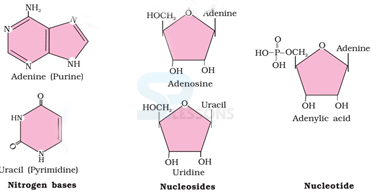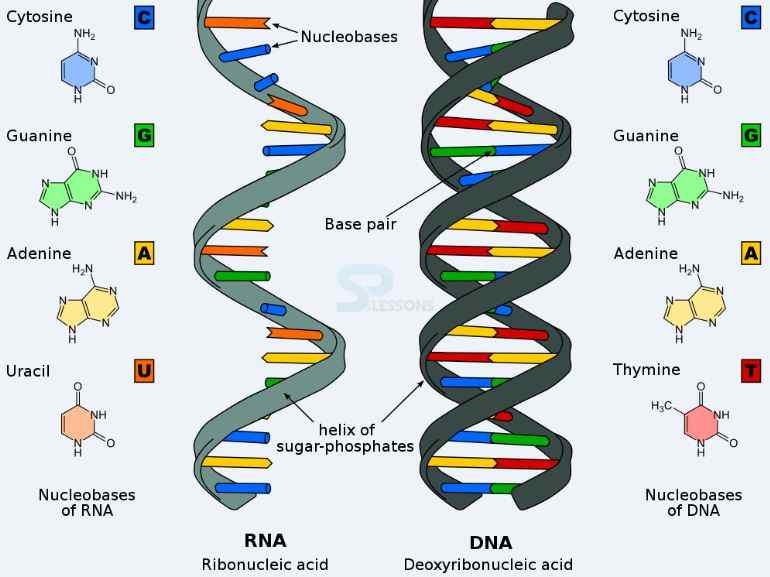 Introduction
Introduction
Q. What is DNA?
Ans: Deoxyribonucleic Acid [DNA] is a thread-like chain of nucleotides carrying the genetic instructions used in the growth, development, functioning and reproduction of all known living organisms and many viruses.
DNA and ribonucleic acid (RNA) are nucleic acids, alongside proteins, lipids and complex carbohydrates they are one of the four major types of macromolecules that are essential for all known forms of life. Most DNA molecules consist of two biopolymer strands coiled around each other to form a double helix.
 DNA
DNA
- Nucleus contains thread-like structures called chromosomes [long continuous molecule of DNA]. These carry genes and help in inheritance or transfer of characters from the parents to the offspring. The chromosomes can be seen only when the cell divides.
- Gene is a unit of inheritance in living organisms. It controls the transfer of a hereditary characteristic from parents to offspring.
- In a cell which is not dividing, dna is present as part of chromatin material. Chromatin material is visible as entangled mass of thread-like structures.
- The nucleosomeis the fundamental subunit of chromatin. Each nucleosome is composed of a little less than two turns of DNA wrapped around a set of eight proteins called histones.
- Whenever the cell is about to divide, the chromatin material gets organized into chromosomes.
- Chromosomes are visible as rod-shaped structures only when the cell is about to divide.
- Chromosomes are composed of DNA and Protein. Chromosomes contain information for inheritance of features from parents to next generation in the form of DNA (deoxyribo nucleic acid) molecules.
- DNA molecules contain the information necessary for constructing and organizing cells. Functional segments of dna are called genes.
Image: Chromosomes
Source: NCERT Text Books
- Living organisms have a number of carbon compounds in which heterocyclic rings can be found.
- When heterocyclic rings are attached to a sugar, they are called nucleosides.
- If a phosphate group is also found esterified to the sugar they are called nucleotides.
- Nucleic acids like DNA and RNA consist of nucleotides
Note: Heterocyclic Rings = A heterocyclic compound or ring structure is a cyclic compound that has atoms of at least two different elements as members of its ring(s). Ester = An organic compound made by replacing the hydrogen of an acid by an alkyl or other organic groups.
- Nucleic acid is a macromolecule that is found in the acid insoluble fraction of any living tissue.
- Together with polysaccharides and polypeptides these comprise the true macromolecular fraction of any living tissue or cell.
- For nucleic acids, the building block is a nucleotide,e. nucleic acids are polymers of nucleotides.
- Since nucleic acids are long chain polymers of nucleotides, they are also called polynucleotides.
- The nucleotides are joined to one another in a chain by covalent bonds between the sugar of one nucleotide and the phosphate of the next, resulting in an alternating sugar-phosphate backbone.
- A nucleotide has three chemically distinct components. One is a heterocyclic compound, the second is a monosaccharide and the third a phosphoric acid or phosphate.
- The sugar found in polynucleotides is either ribose (a monosaccharide pentose) or deoxyribose.
- The heterocyclic compounds in nucleic acids are the nitrogenous bases named Adenine, Guanine, Uracil, Cytosine, and Thymine.
Image: Nucleic Acids
Source: NCERT Text Books
- Every generation of each and every species resembles its ancestors in many ways. How are these characteristics transmitted from one generation to the next?
- It has been observed that nucleus of a living cell is responsible for this transmission of inherent characters, also called heredity.
- The particles in nucleus of the cell, responsible for heredity, are called chromosomes which are made up of proteins and another type of biomolecules called nucleic acids.
- Nucleic acids are responsible for the transfer of characters from parents to off springs. There are two types of nucleic acids — DNA and RNA.
- A nucleic acid containing deoxyribose is called deoxyribonucleic acid (DNA) while that which contains ribose is called ribonucleic acid (RNA).
- Both DNA and RNA contain Adenine, Guanine and Cytosine. The fourth base is Thymine in DNA and Uracil in RNA.
- The structure of DNA is a double strand [helix] whereas RNA is a single strand molecule.
- Hydrogen bonds bind the nitrogenous bases of the two separate polynucleotide strands to make double-stranded DNA.
- The DNA backbone is resistant to cleavage, and both strands of the double-stranded structure store the same biological information. Biological information is replicated as the two strands are separated.
- Within cells, DNA is organized into long structures called chromosomes. During cell division these chromosomes are duplicated in the process of DNA replication, providing each cell its own complete set of chromosomes.
- Eukaryotic organisms (animals, plants, fungi, and protists) store most of their DNA inside the cell nucleus and some of their DNA in organelles, such as mitochondria or chloroplasts.
- In contrast, prokaryotes (bacteria and archaea) store their DNA only in the cytoplasm.
- DNA is the chemical basis of heredity and have the coded message for proteins to be synthesized in the cell.
- There are three types of RNA — mRNA, rRNA and tRNA which actually carry out the protein synthesis in the cell based on the coded message for proteins provided by DNA.
- Ribonucleic acid (RNA) is implicated in various biological roles in coding, decoding, regulation, and expression of genes.
- Cellular organisms use messenger RNA (mRNA) to convey genetic information that directs synthesis of specific proteins.
- Many viruses encode their genetic information using an RNA genome. Example: HIV virus used this technique to proliferate within human body.
Image: DNA and RNA
Source: NCERT Text Books
- DNA is the chemical basis of heredity and may be regarded as the reserve of genetic information.
- DNA is exclusively responsible for maintaining the identity of different species of organisms over millions of years.
- A DNA molecule is capable of self-duplication during cell division and identical DNA strands are transferred to daughter cells.
- Another important function of nucleic acids is the protein synthesis in the cell. Actually, the proteins are synthesized by various RNA molecules in the cell but the message for the synthesis of a particular protein is present in DNA.
- It is known that every individual has unique fingerprints. These occur at the tips of the fingers and have been used for identification for a long time but these can be altered by surgery.
- A sequence of bases on DNA is also unique for a person and information regarding this is called DNA fingerprinting. It is same for every cell and cannot be altered by any known treatment.
- DNA fingerprinting is now used (i) in forensic laboratories for identification of criminals. (ii) to determine paternity of an individual. (iii) to identify the dead bodies in any accident by comparing the DNA’s of parents or children. (iv) to identify racial groups to rewrite biological evolution.
- Recombinant DNA (rDNA) molecules are DNA molecules formed by laboratory methods of genetic recombination (such as molecular cloning) to bring together genetic material from multiple sources, creating sequences that would not otherwise be found in the genome.
- Recombinant DNA is possible because DNA molecules from all organisms share the same chemical structure. They differ only in the nucleotide sequence within that identical overall structure.
- In most cases, organisms containing recombinant DNA have apparently normal phenotypes. That is, their appearance, behavior, and metabolism are usually unchanged.
- The cutting of DNA at specific locations became possible with the discovery of the so-called ‘molecular scissors’- restriction enzymes.
- Restriction enzymes belong to a larger class of enzymes called nucleases. These are of two kinds exonucleases and endonucleases.
- Exonucleases remove nucleotides from the ends of the DNA whereas, endonucleases make cuts at specific positions within the DNA.
- The cut piece of DNA was then linked with the plasmid DNA. These plasmid DNA act as vectors to transfer the piece of DNA attached to it.
- You probably know that mosquito acts as an insect vector to transfer the malarial parasite Into human body.
- In the same way, a plasmid can be used as vector to deliver an alien piece of DNA into the host organism.
- The linking of antibiotic resistance gene with the plasmid vector became possible with the enzyme DNA ligase, which acts on cut DNA molecules and joins their ends. This makes a new combination of circular autonomously replicating DNA created in vitro and is known as recombinant DNA.
- When this DNA is transferred into Escherichia coli, a bacterium closely related to Salmonella, it could replicate using the new host’s DNA polymerase enzyme and make multiple copies. The ability to multiply copies of antibiotic resistance gene in E. coli was called cloning of antibiotic resistance gene in E. coli.
Image: Biotechnology
Source: NCERT Text Books
- Recombinant DNA is widely used in biotechnology, medicine, and research.
- Recombinant DNA is used to identify, map and sequence genes, and to determine their function.
- Recombinant human insulin,
- Recombinant human growth hormone,
- Recombinant blood clotting factor VIII,
- Recombinant hepatitis B vaccine,
- Insect-resistant crops etc.







